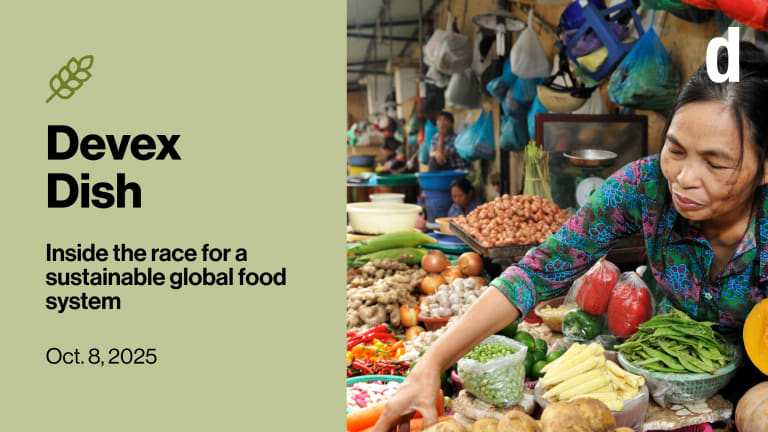
Only 42% of country financial commitment goals made at past Nutrition for Growth, or N4G, summits have been reached or were on track, according to the “2021 Global Nutrition Report.” Only 41% of country impact commitment goals were on course.
Get the inside track on how agriculture, nutrition, sustainability, and more are intersecting to remake the global food system in this weekly newsletter.
The annual publication, which reports on the state of global nutrition and progress toward targets to improve nutrition outcomes as well as financial commitments, comes just two weeks before the 2021 N4G summit, which will be hosted by the government of Japan.
It will be the third time the global pledging moment is held to encourage governments, donors, civil society, and the private sector to commit to improving nutrition outcomes. And it comes as the world is off-track to meet five out of six of the World Health Organization’s targets for maternal, infant and young children’s nutrition.
The GNR found that the 2013 and 2017 N4G summits came up short on meeting their commitments, offering an important lesson for this year’s pledges.
“Poor diets and malnutrition in all its forms remain unacceptably high across the world, highlighting the need for stronger action.”
— Dr. Renata Micha, chair of the GNR’s Independent Expert Group“What we’ve seen when we looked at these past commitments made to date … is that countries are struggling to meet goals for nutrition,” Dr. Renata Micha, chair of the GNR’s Independent Expert Group, told Devex. “When it comes to measuring the impact of those commitments, it has proven quite difficult. Why that is? Because there weren’t clear guidelines or instructions in terms of how these commitments need to get awarded or formulated to allow us to track them efficiently and effectively.”
Forty-three percent of past N4G country commitment goals were “severely or highly affected” by COVID-19, as people with underlying conditions caused by poor nutrition are more susceptible to the disease. The pandemic has added strain to an already inadequate funding landscape.
The picture for non-government donors and civil society organizations was more positive than for governments, with 76% of civil society and 65% of N4G donor non-financial commitments on track or already met.
Data only exists to estimate financing needs for four of the WHO’s nutrition-specific targets: wasting, stunting, anemia, and breastfeeding. The GNR found that meeting targets for all four would cost an average $10.8 billion each year between 2022 and 2030 due the pandemic’s effects. Costs would rise further if nutrition-sensitive needs were taken into account, encompassing all global nutrition targets. Meeting Sustainable Development Goal 2 — no hunger — would cost between $39 billion and $50 billion annually.
That funding is desperately needed: Progress to reduce wasting, stunting, low birth weight, anemia, and childhood obesity are all off track, the GNR found. Around the world, 149.2 million children under age 5 are stunted, meaning they are of low height for their age, while 45.4 million are wasted, meaning they are of low weight for their height. Anemia rates are showing no progress or worsening in 161 countries.
More than 2.2 billion people, or 40% of all men and women worldwide, are overweight or obsese, and no country is on track to reverse the rise of adult obesity — one of the diet-related noncommunicable disease targets. No country in Africa is on track to meet any of the other diet-related targets, which include salt intake, diabetes, and raised blood pressure. Only a few high-income Western countries are on track to reduce diabetes and lower blood pressure.
“Poor diets and malnutrition in all its forms remain unacceptably high across the world, highlighting the need for stronger action,” Micha said. “We do have the tools and the know-how to win that fight. So that fight is winnable. It’s a matter of stepping up the actions and taking up coordinated efforts to address this global nutrition crisis holistically.”
No region in the world is meeting recommendations of healthy diets as fruit and vegetable intake remains about 50% under targets. More than 12 million adult deaths caused by NCDs are linked to poor diets, the GNR found.
Diets are also harming the planet: The environmental impacts of the food system increased by 14% since 2010. The GNR found that animal-source foods are responsible for the majority of greenhouse gas emissions. Food and agriculture production accounts for 35% of global total emissions.
The report calls for countries to ensure that future goals are SMART: specific, measurable, achievable, relevant, and time-bound. Only 29% of past N4G goals met SMART criteria.
In response to the difficulty in tracking commitments over time, the GNR launched the Nutrition Accountability Framework in September, which provides an official means to track goals coming out of this year’s N4G in Tokyo. Micha said the metrics have to balance being rigorous enough to provide a clear picture of progress, while not being so onerous that parties don’t report at all.
This will be key to ensuring that any entity making a commitment next month can be held accountable for progress made, she said.
“We have developed the tools and the guidance to facilitate the recording or the registration of nutrition commitments with consistent criteria so that over time we’re able to measure progress against what they said they would do, to effectively ensure that these promises translate into action,” Micha said. “This Nutrition Year of Action decision-makers must leverage Nutrition for Growth as a reset moment to come together and step up and make nutrition commitments.”









